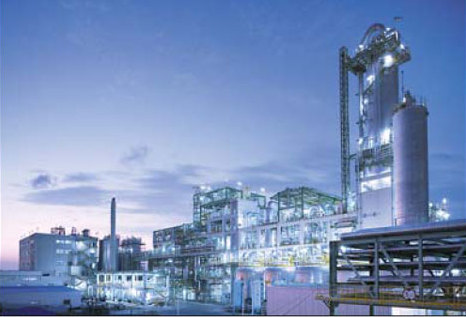 |
|
The Bayer integrated site in Shanghai. |
Located in the Shanghai Chemical Industry Park, about 50 km from Shanghai city center, the Bayer integrated site is under operation. Developed by Bayer MaterialScience, the manufacturing facility is its largest investment outside Germany.
The site of Bayer MaterialScience, one sub group under the chemical and pharmaceutical company Bayer, consists mainly of facilities to manufacture polycarbonate, polyurethane raw materials and coating raw materials. Total investment planned for the site up until 2012 amounts to 2.1 billion euros ($2.8 billion), among which 700 million euros ($943 million) are scheduled for the period from 2009 until 2012.
This month Bayer MaterialScience successfully started production at its new 350,000-ton-per-year MDI complex at the site, which is the largest MDI facility of its kind in the world. The company has also broken ground for a 250,000-ton-per-year TDI plant at the site, which is scheduled to come on stream in 2010.
MDI is a raw material used primarily for the production of polyurethane rigid foams, which have better insulating properties than any other material on the market. Two of their main applications are in the refrigeration chain and as thermal insulation in the building industry. TDI is used in large quantities in the production of flexible polyurethane foam for upholstered furniture, mattresses, and car seats.
"With these projects Bayer MaterialScience is emphasizing its commitment to growth markets in China and the whole Asia-Pacific region. Innovative process technologies strengthen our cost leadership in isocyanate production and thus our competitiveness," said Patrick Thomas, chairman of the board of management of Bayer MaterialScience.
For Bayer MaterialScience, China is already the most important market in the Asia-Pacific region and currently its third largest national market worldwide.
"We are confident that our materials will continue to exhibit good growth rates there," said Thomas.
China is already the world's largest single market for polycarbonates and it is expected to become the largest global consumer of polyurethanes by 2015.
Social responsibility
As one of the world's leading chemicals producers, environmental protection is a focus of Bayer's corporate social responsibility. The company has launched its global Bayer Climate Program, with which it will further reduce its CO2 emissions from its production facilities and develop new solutions for increasing climate protection and dealing with climate change.
Bayer will invest 1 billion euros ($1.35 billion) in climate-related research and development and other projects in the next three years. Work has already started on some of the program's projects.
These include a global concept for zero-emission buildings for offices and other industrial buildings, known as "eco-commercial buildings"; the development of stress-tolerant plants and systems to encourage the effective use of crops for biofuels; and the Bayer Climate Check for optimizing production processes.
Several new technologies are also used at the Bayer site in Shanghai to achieve energy-efficient and environmentally responsible production.
"By using advanced technology and an energy-efficient setup at the site, the Bayer Integrated Site Shanghai is able to save approximately 100 megawatts, compared with conventional production plants. These savings can supply up to 10,000 homes," Thomas said.
The new TDI facility, for example, features a modern gas phase process. This enables energy savings of up to 60 percent compared with a conventional plant of the same size. The new process technology uses up to 80 percent less solvent, and cuts investment costs for this type of large-scale facility by some 20 percent.
"This enables us to further consolidate our leading position in the world market for polyurethanes with optimized cost structures," Thomas said.
(China Daily October 30, 2008)